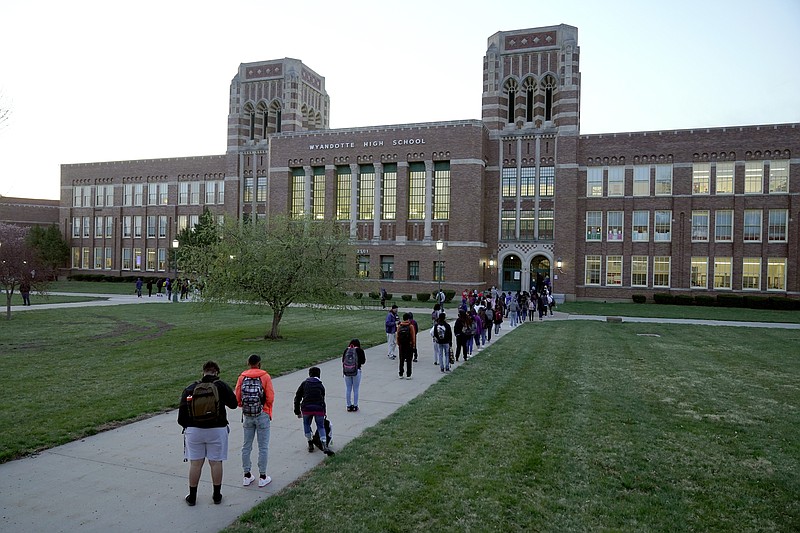Large numbers of students are not returning to the classroom even as more schools reopen for full-time, in-person learning, according to a survey released Wednesday by the Biden administration.
The findings reflect a nation that has been locked in debate over the safety of reopening schools during the coronavirus pandemic. Even as national COVID-19 rates continued to ebb in February, key measures around reopening schools barely budged.
Nearly 46 percent of public schools offered five days a week of in-person learning to all students in February, according to the survey, but just 34 percent of students were learning full time in the classroom. The gap was most pronounced among older K-12 students, with just 29 percent of eighth-graders getting five days a week of learning at school.
With the new findings, President Joe Biden came no closer to meeting his goal of having most elementary schools open five days a week in his first 100 days. School offerings were nearly identical to what was reported a month before. But among eighth-grade students, there was a slight shift from fully remote to hybrid learning.
Speaking at a coronavirus briefing on Wednesday, White House COVID-19 adviser Andy Slavitt described the findings as a step forward.
“This is encouraging early data covering the month of February that shows progress toward the president’s goal to have K-8 schools open five days a week,” Slavitt said.
The findings are based on a survey of 3,500 public schools that serve fourth-graders and 3,500 schools that serve eighth-graders. It’s based on data from schools in 37 states that agreed to participate. This is the second round of data released from a survey started by the Biden administration to evaluate progress in reopening schools.
The data capture a month that saw building momentum in the push to reopen schools. In February, the Centers for Disease Control and Prevention declared schools could safely reopen with masks, social distancing and other precautions. Days later, Biden reframed his goal around reopening schools after critics said his previous pledge lacked ambition.
Since then, schools have continued to reopen as more teachers get vaccines and as some states loosen social distancing requirements. More recent estimates from the data service Burbio found, as of Sunday, more than 55 percent of K-12 students were back in the classroom full time.
As in January, the new federal data showed dramatic disparities based on region and race. In the South, slightly more than half of all fourth graders were learning entirely at school in February, an uptick from the month before. In the same period, by contrast, the Northeast saw a decrease in the rate of students learning in the classroom five days a week, from 23 percent to 19 percent.
Overall, more than a third of students in the South and Midwest were learning entirely at school, compared with less than a quarter in the West and Northeast, according to the survey.
White students continued to be far more likely to be back in the classroom, with 52 percent of white fourth-graders receiving full-time, in-person instruction. By contrast, less than a third of Black and Hispanic fourth-graders were back at school full time, along with just 15 percent of Asian students.
The results do not indicate whether students are learning remotely by choice or because their schools do not offer an in- person option. The mismatch between what schools are offering and what students are getting is at least partly explained by big urban districts that have been slow to offer in-person options. However, it’s clear at least some students are opting to stay remote even after their schools reopen classrooms.
In New Mexico, where all school districts were expected to be open for in-person learning this week, some students stayed back. Among them was 14-year-old Jonathan Chilton, a freshman in Santa Fe, who watched class from his laptop on Tuesday while around half of his district attended in-person. He was reconsidering his choice, though, after dealing with internet issues and a teacher who was split between two audiences.
“Before it was like — she was just sitting down and talking to everyone,” Jonathan said. “We try to understand what she’s saying sometimes because, like, it lags when she’s in the classroom.”
The survey’s findings around race align with previous findings from some of the nation’s largest school districts, where Black students have returned at far lower rates than their white classmates — a disparity that’s believed to come down at least partly to trust. Advocates said more must be done to convince parents their children will be safe in school, especially Black families who have been disproportionately affected by the coronavirus.
Although wide racial disparities persisted in the new round of data, the Education Department saw a glimmer of hope in a slight increase among Black students learning fully in-person. From January to February, the rate ticked up from 28 percent to 30 percent.

